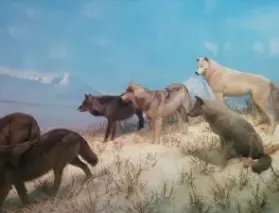 In his book, Nothing Holy About It, Tim Burkett lists the four foundations of mindfulness as:
In his book, Nothing Holy About It, Tim Burkett lists the four foundations of mindfulness as:
Mindfulness of our body;
Mindfulness of our feelings;
Mindfulness of mental formations; and
Mindfulness of our environment.
Each of these four poses unique problems for us as we try to become more mindful, but here my focus is on the fourth, mindfulness of our environment.
Obviously, humankind as a whole currently suffers from a lapse of mindfulness about our natural environment, which we treat rather disgracefully. I am not using the word “environment” here in this ecological sense, however; I am using it simply to refer to our immediate surroundings — that part of the world each of us can perceive here and now with our senses.
Simple Mindfulness
There is an exercise I sometimes do when I wish to be more mindful of my immediate environment. I often do this when I take a walk by myself. In this exercise I take a little time to focus on the information that I am receiving from each of my five senses. I start with the sense of touch. Awareness of the sense of touch follows naturally from mindfulness of the body.
I first focus on the feeling at the bottom of my feet as I walk. This literally grounds my awareness. While keeping a little of my awareness in my feet, I move my awareness up my body — to the movement I feel in my hips, to an awareness of my spine and its alignment, to the movement of my arms. Then I feel the wind and the warmth or coolness of the day upon my skin. I feel my breathing. I continue this until I am deeply aware of everything that is entering me through the sense of touch. Then I move on to other senses.
Often, there is not a lot going on with the sense of taste, unless I have stopped for a cup of coffee. Sometimes there is quite a variety of smells. Without judging them as good or bad smells, I try to bring each into awareness and to explore its unique quality.
Then I move on to my sense of hearing. Often there is a great variety of different sounds and I try to bring as many into my awareness as I can. Again, without judging them. Finally, I focus on the sense of sight, particularly the sights that are close at hand.
There is often a great deal to see — too much to bring entirely into awareness in a short amount of time. Often, I select just a small part of my visual field and focus on it. Sometimes I pretend I am a painter preparing to paint this area. In the act of painting, I would have to become aware of each detail, its shape and color, to render it accurately onto a canvas. The great painters are masters of visual awareness, and studying their works can teach us about being more visually aware.
Done well, this exercise anchors me to the here and now of the present moment and deeply aware of my immediate surroundings.
Adding Knowledge
One of the things that makes this sensory exercise difficult is that my mind wants to think about the things I am sensing. Once my mind starts thinking or daydreaming, my attention can quickly get diverted into any number of possible channels, each having little or no connection with my immediate sensory environment. Thinking can be a distraction from mindfulness of our environment, but it also can enhance our awareness.
As an example, while I was in college, I took a course called Minnesota Plant Life. This course was an introduction to the great variety of plants that grows in my home state. This includes such plants as mosses and ferns, trees and shrubs, and the smaller flowering plants. Before I took this class, the vegetation of a forest was nothing to me but a blur of brown and green. After I took it, out of the brown and green blur I started to see a great variety of distinct shapes and forms.
Around the time I was taking this class, I met the woman who has been my wife for the past 38 years, and I introduced her to the plants I was learning about. Ever since we have been going out together to see the hepatica, anemones, bloodroot, wild ginger, and trilliums of early spring, the hawkweed and Indian paintbrush in the summer, and touch-me-nots, lead plant and asters in the fall along with hundreds of other plants. Awareness of these plants has been a continuing source of joy in our lives.
There are, of course, many other kinds of knowledge that can help us be more aware of our surroundings. In the city, knowledge of such things as design and architecture can enhance our awareness of the built environment and other kinds of knowledge can enhance our awareness of the layers of meaning in the signs and symbols that are present everywhere.
Other people, of course, are something else that often is a part of our immediate environment. Mindfulness of people — their sorrows and joys, hopes and aspirations — can be particularly rewarding. The knowledge we need for this usually does not come from reading or taking courses, but from talking and caring about what is going on in people’s life. Here, as with many other aspects of mindfulness, if we are able to see people without rushing to judgment we will perceive more because we will be open to more. Openness helps us be more mindful, and mindfulness helps us be more open.
Distractions
In section III of his poem Burnt Norton, T.S. Eliot wrote of being “distracted from distraction by distraction.” He wrote this nearly 85 years ago, when newspapers and the radio were the primary distracting media. The ubiquitous rectangular screens of televisions, computers and cell phones, that are now a major presence in our environment, had not yet been conceived. Were he alive today, perhaps he would write “distracted from distraction by very distracting distractions.” The type and quantity of distractions keeps increasing. Distraction is the opposite of mindfulness, so if we want to work on being more mindful of our environment, we need to think seriously about distractions.
Media can make us more aware, but we need to be careful. I know people who think they must catch the news every day in order to stay up with the world. Personally, I avoid the news as much as I can.
Do we really need to know what’s going on all over the world? Can we trust the news media? Can we trust our own mind to keep a balanced perspective when bombarded with news reports that focus on the most sensational and troubling things that are going on in the country or the world? And most seriously of all, can we trust our heart to stay open over against the interminable horrors and human suffering that the news imposes on our immediate sensory environment? The world population is currently 7,600,000,000 (give or take a hundred million). Potentially, the fate of any one of these people might be brought to our attention by the media. Can one poor little heart maintain compassion against such numbers? Mine can’t.
If you take up the challenge of maintaining greater mindfulness of your immediate environment, you cannot help but think about what such media does to the quality of your awareness. Most of us take the presence of all this distraction for granted, but we have some choice in the matter. It’s worth exercising that choice.
Abstractions
Abstract knowledge, such as scientific theories, can cause us to be abstracted from our immediate environment, for instance when we get caught up in our thinking and lose touch with what is happening around us. But abstract knowledge can also help us experience our sensory environment more deeply. Here is an example.
A while back I was camping with my son and daughter, who are both conversant with the latest findings of science. We were sitting around a campfire roasting marshmallows. While gazing at the fire, we started talking about the nature of light and photons.
As we were talking, one of us mentioned that the radiant heat we felt and light we saw from the fire was actually sunlight that had been stored by the tree. The burning logs were releasing photons gathered during the past thirty or forty years. We were feeling the warmth of past summer days.
The thought of photons got us talking about Einstein’s great equation E=MC2. That the sun has been radiating photons for those past summers, and a few billion summers prior to those, is all to do with that simple but intimidating equation. The equation tells us that a little matter generates a huge amount of energy. Thus the sun has warmed the earth for those billions of years which has given time for both us and the trees to evolve; hopefully it will go on for a few billion more.
Thoughts of the sun and Einstein’s equation brought our discussion around to the unique relationship between the strength of gravity and the strength of electromagnetic energy — a remarkable ratio that guarantees that stars must be large and relatively long lasting. There are 39 magnitudes of difference between the strength of gravity and the strength of the electromagnetic force (in ordinary matter). Yet if you increased or decreased that ratio by one percent, a sun like ours would not exist. From whence that ratio?
We pondered that question for a while and it led to the question of just how a universe like this — one that continues to evolve into greater complexity and novelty — just happens to pop into existence? And with that formidable question in mind, we got up and went out to a dark place to look at the stars — bringing with us the whole wonderful mystery of the cosmos and ourselves as creations of that cosmos. The stars that night were wonder-filled.
That, for us, was an example of how abstract knowledge can enhance sensory awareness and add a layer of depth and beauty to it — how to feel quantum electrodynamics in the warmth of a fire and taste Maxwell’s equations in a toasted marshmallow.
Summary
An oft-quoted line from a John Berryman poem reads: “ever to admit you’re bored means you lack inner resources.” Mindfulness is a healthy and inexpensive remedy for boredom. When we live mindfully within it, our immediate environment is rich and stimulating. A truly mindful person, I suspect, will see more walking about their neighborhood than a highly distracted person will see traveling around the world.
Mindfulness is the ticket for the journey of a lifetime.
Learn about Membership in the Spiritual Naturalist Society
__________
The Spiritual Naturalist Society works to spread awareness of spiritual naturalism as a way of life, develop its thought and practice, and help bring together like-minded practitioners in fellowship.













